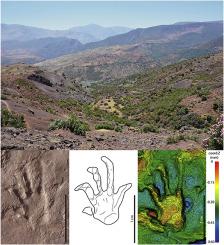当前位置:
X-MOL 学术
›
J. Afr. Earth Sci.
›
论文详情
Our official English website, www.x-mol.net, welcomes your feedback! (Note: you will need to create a separate account there.)
A new ichnofauna from the Permian of the Zat Valley in the Marrakech High Atlas of Morocco
Journal of African Earth Sciences ( IF 2.3 ) Pub Date : 2020-12-01 , DOI: 10.1016/j.jafrearsci.2020.103973 Jean-David Moreau , Naima Benaouiss , Abdelilah Tourani , J.-Sébastien Steyer , Michel Laurin , Karin Peyer , Olivier Béthoux , Ali Aouda , Nour-Eddine Jalil
Journal of African Earth Sciences ( IF 2.3 ) Pub Date : 2020-12-01 , DOI: 10.1016/j.jafrearsci.2020.103973 Jean-David Moreau , Naima Benaouiss , Abdelilah Tourani , J.-Sébastien Steyer , Michel Laurin , Karin Peyer , Olivier Béthoux , Ali Aouda , Nour-Eddine Jalil

|
Abstract A new ichnofauna from the Permian of Morocco is described in details: it is the first Palaeozoic ichnofauna from the Zat Valley in Marrakech High Atlas. The new tracksite was found in the Tighdouine region, in the middle-upper Permian of the Cham-el-Houa Siltstone Formation. An abundant and diverse ichnoassemblage composed of both protostomian (probably arthropods and annelids) traces and vertebrate tracks is recorded. The presence of protostomian burrows and traceways, associated with tetrapod tracks corresponds to the Scoyenia ichnofacies. Protostomian traces are ascribed to Diplichnites gouldi, Diplopodichnus biformis, Scoyenia cf. gracilis and Spongeliomorpha carlsbergi. Tetrapod tracks include more than 70 tracks attributed to Amphisauropus, Erpetopus, Hyloidichnus, Characichnos, and indeterminate tracks. The co-occurrence of tetrapod tracks (both walking and swimming tracks), protostomian traces, mudcracks, ripple marks, as well as the lithological features of the track-bearing levels, indicate regularly inundated depositional environments during periods of high discharge under a local seasonal climate. A sedimentological analysis shows that the depositional environments evolved from braided-meandering systems to alluvial floodplains. The track-bearing surfaces are mainly preserved in crevasse splays, levees and pond deposits. This newly discovered ichnofauna helps to better reconstruct the palaeoenvironments of the Marrakech High Atlas in Morocco during the Permian, and enlarges the palaeogeographic distribution of important ichnotaxa.
中文翻译:

来自摩洛哥马拉喀什高地图集扎特谷二叠纪的一种新的鱼类群落
摘要 详细描述了摩洛哥二叠纪的一种新的鱼类群落:它是马拉喀什高阿特拉斯地区扎特河谷的第一个古生代鱼类群落。新的轨道地点位于 Tighdouine 地区,位于 Cham-el-Houa 粉砂岩组的中上二叠纪。记录了由原生动物(可能是节肢动物和环节动物)踪迹和脊椎动物踪迹组成的丰富多样的鱼类组合。与四足动物轨迹相关的原生动物洞穴和痕迹的存在对应于 Scoyenia ichnfacies。原生动物的踪迹归因于 Diplichnites gouldi、Diplopodichnus biformis、Scoyenia cf。gracilis 和 Spongeliomorpha carlsbergi。四足动物的足迹包括 70 多条属于 Amphisauropus、Erpetopus、Hyloidichnus、Characichnos 的足迹和不确定的足迹。四足动物轨迹(步行和游泳轨迹)、原生动物痕迹、泥裂、波纹痕迹以及轨道承载层的岩性特征的同时出现,表明在局部季节性高流量期间经常被淹没的沉积环境气候。沉积学分析表明,沉积环境从辫状蜿蜒系统演变为冲积漫滩。轨道承载面主要保存在裂隙口、堤坝和池塘沉积物中。这种新发现的鱼群有助于更好地重建二叠纪时期摩洛哥马拉喀什高阿特拉斯的古环境,扩大重要鱼群的古地理分布。以及轨道承载水平的岩性特征,表明在当地季节性气候下的高流量期间经常被淹没的沉积环境。沉积学分析表明,沉积环境从辫状蜿蜒系统演变为冲积漫滩。轨道承载面主要保存在裂隙口、堤坝和池塘沉积物中。这种新发现的鱼群有助于更好地重建二叠纪时期摩洛哥马拉喀什高阿特拉斯的古环境,扩大重要鱼群的古地理分布。以及轨道承载水平的岩性特征,表明在当地季节性气候下的高流量期间经常被淹没的沉积环境。沉积学分析表明,沉积环境从辫状蜿蜒系统演变为冲积漫滩。轨道承载面主要保存在裂隙口、堤坝和池塘沉积物中。这种新发现的鱼群有助于更好地重建二叠纪时期摩洛哥马拉喀什高阿特拉斯的古环境,扩大重要鱼群的古地理分布。沉积学分析表明,沉积环境从辫状蜿蜒系统演变为冲积漫滩。轨道承载面主要保存在裂隙口、堤坝和池塘沉积物中。这种新发现的鱼群有助于更好地重建二叠纪时期摩洛哥马拉喀什高阿特拉斯的古环境,扩大重要鱼群的古地理分布。沉积学分析表明,沉积环境从辫状蜿蜒系统演变为冲积漫滩。轨道承载面主要保存在裂隙口、堤坝和池塘沉积物中。这种新发现的鱼群有助于更好地重建二叠纪时期摩洛哥马拉喀什高阿特拉斯的古环境,扩大重要鱼群的古地理分布。
更新日期:2020-12-01
中文翻译:

来自摩洛哥马拉喀什高地图集扎特谷二叠纪的一种新的鱼类群落
摘要 详细描述了摩洛哥二叠纪的一种新的鱼类群落:它是马拉喀什高阿特拉斯地区扎特河谷的第一个古生代鱼类群落。新的轨道地点位于 Tighdouine 地区,位于 Cham-el-Houa 粉砂岩组的中上二叠纪。记录了由原生动物(可能是节肢动物和环节动物)踪迹和脊椎动物踪迹组成的丰富多样的鱼类组合。与四足动物轨迹相关的原生动物洞穴和痕迹的存在对应于 Scoyenia ichnfacies。原生动物的踪迹归因于 Diplichnites gouldi、Diplopodichnus biformis、Scoyenia cf。gracilis 和 Spongeliomorpha carlsbergi。四足动物的足迹包括 70 多条属于 Amphisauropus、Erpetopus、Hyloidichnus、Characichnos 的足迹和不确定的足迹。四足动物轨迹(步行和游泳轨迹)、原生动物痕迹、泥裂、波纹痕迹以及轨道承载层的岩性特征的同时出现,表明在局部季节性高流量期间经常被淹没的沉积环境气候。沉积学分析表明,沉积环境从辫状蜿蜒系统演变为冲积漫滩。轨道承载面主要保存在裂隙口、堤坝和池塘沉积物中。这种新发现的鱼群有助于更好地重建二叠纪时期摩洛哥马拉喀什高阿特拉斯的古环境,扩大重要鱼群的古地理分布。以及轨道承载水平的岩性特征,表明在当地季节性气候下的高流量期间经常被淹没的沉积环境。沉积学分析表明,沉积环境从辫状蜿蜒系统演变为冲积漫滩。轨道承载面主要保存在裂隙口、堤坝和池塘沉积物中。这种新发现的鱼群有助于更好地重建二叠纪时期摩洛哥马拉喀什高阿特拉斯的古环境,扩大重要鱼群的古地理分布。以及轨道承载水平的岩性特征,表明在当地季节性气候下的高流量期间经常被淹没的沉积环境。沉积学分析表明,沉积环境从辫状蜿蜒系统演变为冲积漫滩。轨道承载面主要保存在裂隙口、堤坝和池塘沉积物中。这种新发现的鱼群有助于更好地重建二叠纪时期摩洛哥马拉喀什高阿特拉斯的古环境,扩大重要鱼群的古地理分布。沉积学分析表明,沉积环境从辫状蜿蜒系统演变为冲积漫滩。轨道承载面主要保存在裂隙口、堤坝和池塘沉积物中。这种新发现的鱼群有助于更好地重建二叠纪时期摩洛哥马拉喀什高阿特拉斯的古环境,扩大重要鱼群的古地理分布。沉积学分析表明,沉积环境从辫状蜿蜒系统演变为冲积漫滩。轨道承载面主要保存在裂隙口、堤坝和池塘沉积物中。这种新发现的鱼群有助于更好地重建二叠纪时期摩洛哥马拉喀什高阿特拉斯的古环境,扩大重要鱼群的古地理分布。


























 京公网安备 11010802027423号
京公网安备 11010802027423号